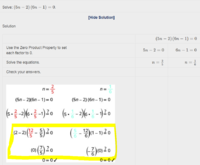help with quadratic equations when checking.
- Thread starter bobisaka
- Start date
Otis
Elite Member
- Joined
- Apr 22, 2015
- Messages
- 4,592
Hi bobisaka. They've substituted each value for n, directly above the highlighted box. Next, they evaluate those expressions (that is, they do the arithmetic). The evaluation steps are shown inside the highlighted box.… I don't fully understand … the equations … in the highlighted box …
The order of operations tells us to do multiplications before subtractions. Therefore, the first line inside the box shows the results of the multiplications:
In the left column, they multiplied 5·52 to get 2, and they multiplied 6·52 to get 12/5.
In the right column, they multiplied 5·61 to get 5/6, and they multiplied 6·61 to get 1.
The second line inside the box shows the results of the subtractions:
In the left column, 2 - 2 is 0, and 512−55 is 57.
In the right column, 65−612 is 6−7, and 1 - 1 is 0.
Multiplying any amount by zero results in zero; therefore, in each case, the substituted value of n results in the statement 0=0 -- which is true. That completes the check.
Does this answer your question, or were you thinking about something else?
?
(5n-2)(6n-1).
Can you please tell me what the above equals if n =2?
If 7*Y =0, then what number or numbers, if any can Y equal?
First question:
(10-2)(12-1)
8*11 = 88
Second Question:
7y/7 = 0/7
y=0
Hey yeah much clearer. I didn't think the next steps thoroughly as it was written, but answered it all within that first step.Hi bobisaka. They've substituted each value for n, directly above the highlighted box. Next, they evaluate those expressions (that is, they do the arithmetic). The evaluation steps are shown inside the highlighted box.
The order of operations tells us to do multiplications before subtractions. Therefore, the first line inside the box shows the results of the multiplications:
In the left column, they multiplied 5·52 to get 2, and they multiplied 6·52 to get 12/5.
In the right column, they multiplied 5·61 to get 5/6, and they multiplied 6·61 to get 1.
The second line inside the box shows the results of the subtractions:
In the left column, 2 - 2 is 0, and 512−55 is 57.
In the right column, 65−612 is 6−7, and 1 - 1 is 0.
Multiplying any amount by zero results in zero; therefore, in each case, the substituted value of n results in the statement 0=0 -- which is true. That completes the check.
Does this answer your question, or were you thinking about something else?
?
Thanks.
Steven G
Elite Member
- Joined
- Dec 30, 2014
- Messages
- 14,591
It is best that when you have 7y=0 to just realize that for a product to equal zero one (or more) of the factors MUST be 0.First question:
(10-2)(12-1)
8*11 = 88
Second Question:
7y/7 = 0/7
y=0
Since 7*y = 0 and 7= 0, then y=0
So you noticed that in (5n-2)(6n-1), we are multiplying (5n-2) and (6n-1). Very good.
As a result this, if (5n-2)(6n-1)=0, then either (5n-2) = 0 or (6n-1)=0
Now if (5n-2) =0, then 5n= 2 or n= 2/5 OR (6n-1)=0, then 6n=1 or n=1/6.
Is this all clear now???

